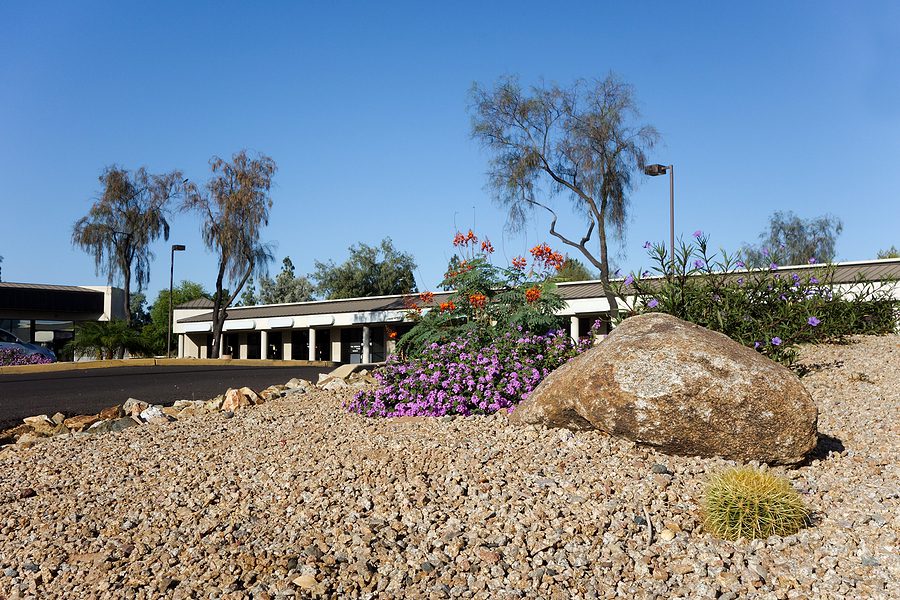Your Albuquerque Xeriscaping Plan for Spring 2022 and Beyond

Xeriscaping is a method of planning landscapes to reduce or eliminate the need for watering. In most situations, this amounts to landscaping utilizing xeriscaping, which requires a tiny amount of water each week or no water at all, other than water given naturally, i.e., rain. The objective of this page is to explain what xeriscaping is so that homeowners and business owners may learn about it and possibly consider using it for landscaping their property here in Albuquerque, NM.
For a good reason, xeriscaping landscape design is becoming increasingly popular in Albuquerque homes and businesses. Xeriscaping is visually appealing, and its Xeriscaping landscape designs require little to no irrigation, as attractive gravel and native plants demand less water. The climate in the southwestern United States, notably New Mexico, receives little precipitation, with most cities receiving about 11 to 12 inches of rain per year. Xeriscape gardening is ideal for Albuquerque and the rest of New Mexico’s low yearly moisture output.
The arid climate of Albuquerque, NM, xeriscaping is the ideal landscaping option for the region. It does not always rain in Albuquerque for months at a time. Water has become the 21st century’s gold since it has grown scarce due to overuse and has become more expensive. Large water bills equate to an increasing annual expense for homeowners. Lower water bills are the result of xeriscaping. There is an initial expense to put xeriscape landscaping on a property, but once it is in place, homeowners will have cheaper water costs each month and year following. During the spring and summer, Albuquerque has compulsory watering days. Watering days are not an issue for Albuquerque residents who use xeriscaping.
Because water has become scarce, the popularity of xeriscaping has soared in the last 30 years. It translates into cheaper water costs and conserves water year-round. Xeriscaping benefits the environment since it employs plants native to the region, which results in an enhanced natural balance to the area, as opposed to planting a massive grass lawn that consumes amounts of water and introduces masses of non-native grass pollen into the local atmosphere. Plants used in xeriscaping are ideal for the arid southwest region since they require very little irrigation, and if they need water, it is very little.
Xeriscaping landscaping typically entails removing traditional grass laws and large water-hungry flower beds and replacing them with beautiful decorative gravel, water retaining mulched flower beds, well-designed drip irrigation systems with direct water to plant water lines featuring water-conserving 12 to 2 gallon per hour bubblers, and a large number of water-conserving native plants.
Albuquerque landscaping xeriscaping plants to consider are as follows:
Peppermint, Weeping Bottlebrush, Incense Cedar, Cypress, Eucalyptus, Juniper, Olive, Pine, California Pepper, Bottle Tree, Palo Verde, Western Redbud, Desert Willow, Crepe Myrtle, Chilean Mesquite, Pomegranate, Oak, Idaho Locust, Chaste Tree, Bearberry, Shrubby Wormwood, California Lilac, Brittlebush, Flannelbush, Christmasberry, California Tree Mallow, Purple Xerophytes are plants that have adapted to the arid environs of the Southwest, such as Albuquerque, New Mexico.
The dry environment of Albuquerque, NM, allows landscaping businesses like R & S Landscaping to grow a wide range of xerophytes such as Acacia, Peppermint, Weeping Bottlebrush, and Incense Cedar.
Types of Xeriscaping Plants
According to studies, xeriscaping may reduce water usage by 40 to 80 percent, depending on the irrigation system watering schedule and daily or semi-daily watering levels. Homes that used 1500 gallons of water per month for landscaping have seen their water use cut to as little as 400 gallons per month.
Xeriscaping design relies on drip lines that are tailored to each plant. Drip bubblers and soaker hoses distribute water to each established plant in the design, reducing waste and evaporation. Dripline bubblers supply specified amounts of water to the plant (0.5 gallons to 2 gallons per hour).
Irrigation systems are designed to turn on and off at specified times of day and supply specific volumes of water throughout the landscaping each time the system is switched on and operates. When combined with plant installations that include appropriate mulch, this technology ensures that water provided to the plant is delivered directly. The ground now surrounding the plant is kept moist, keeping the plant hydrated for a more extended amount of time. Xeriscape landscaping requires less continuing upkeep. Its principal characteristics include low maintenance landscaping rocks, landscaping bed covers such as pecan shells and bark chips, and significantly fewer plants, making it less expensive and easier to manage.
Xerophytes are plants that have adapted to the arid environs of the Southwest, such as Albuquerque, New Mexico. The dry environment of Albuquerque, NM, allows landscaping businesses like R & S Landscaping to grow a wide range of xerophytes such as Acacia, Peppermint, Weeping Bottlebrush, and Incense Cedar.
Cactus may be found in abundance throughout the Southwest’s natural settings. Cactus species native to North and South America are numerous, providing landscaping businesses like R & S Landscaping in Albuquerque, NM, with a diverse range of options when constructing landscape designs for their clients. Cactus has evolved a variety of morphological characteristics during its existence, including needles, large, thick round leaves, and wax skin coverings, all of which help it survive the Southwest’s periodic rainfall and droughts.
